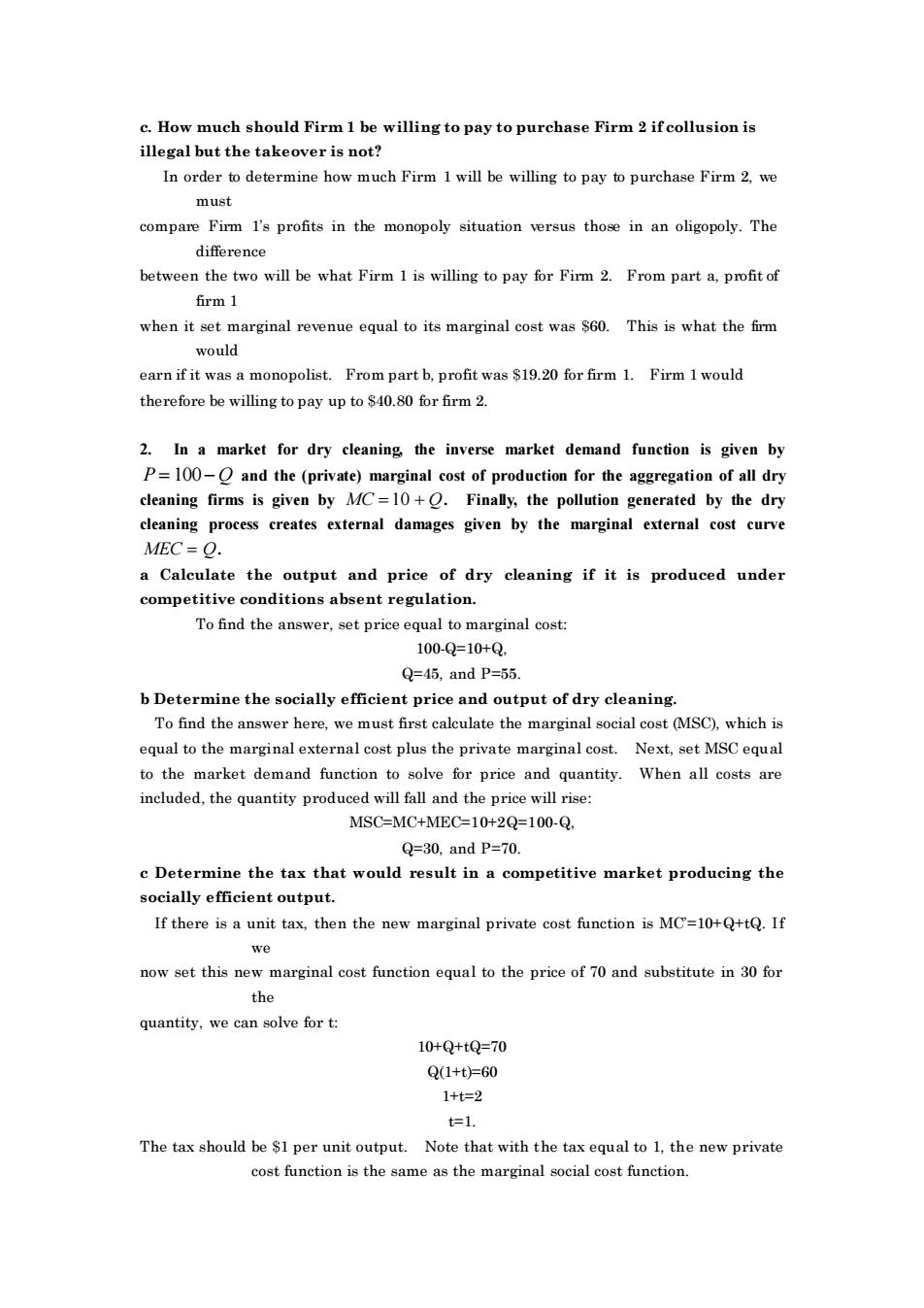正在加载图片...

How much should Firm1 be willing to pay to purchase Firm 2 ifcollusion is illegal but the takeover is not? In order to determine how much Firm 1 will be willing to pay to purchase Firm 2.we must compare Firm I's profits in the monopoly situation versus those in an oligopoly.The difference between the two will be what Firm 1 is willing to pay for Firm 2.From part a,profit of firm 1 when it set marginal revenue equal to its marginal cost was $60.This is what the firm would earn if it was a monopolist.From part b,profit was $19.20 for firm 1.Firm I would therefore be willing to pay up to $40.80 for firm 2. 2.In a market for dry cleaning the inverse market demand function is given by P=100-O and the (private)marginal cost of production for the aggregation of all dry cleaning firms is given by MC=10+.Finally,the pollution generated by the dry cleaning process creates external damages given by the marginal external cost curve MEC=0. a Calculate the output and price of dry cleaning if it is produced under competitive conditions absent regulation. To find the answer,set price equal to marginal cost: 00-Q=10+Q Q=45,and P=55 b Determine the socially efficient price and output of dry cleaning. To find the answer here,we must first calculate the marginal social cost (SC).which is Next,set MSCequal to the market demand function to solve for price and quantity. When all costs are included,the quantity produced will fall and the price will rise: MSC=MC+MEC=10+2Q=100-Q. Q=30,andP=70, c Determine the tax that would result in a competitive market producing the socially efficient output. If there is a unit tax,then the new marginal private cost function is MC=10+Q+tQ.If now set this new marginal cost function equal to the price of 70 and substitute in 30 for the quantity,we can solve for t: 10+Q+tQ=70 91+t60 1+t=2 t=1. Thetax shou unit oupu.Note that with the the new private cost fction is themarginal cost functionc. How much should Firm 1 be willing to pay to purchase Firm 2 if collusion is illegal but the takeover is not? In order to determine how much Firm 1 will be willing to pay to purchase Firm 2, we must compare Firm 1’s profits in the monopoly situation versus those in an oligopoly. The difference between the two will be what Firm 1 is willing to pay for Firm 2. From part a, profit of firm 1 when it set marginal revenue equal to its marginal cost was $60. This is what the firm would earn if it was a monopolist. From part b, profit was $19.20 for firm 1. Firm 1 would therefore be willing to pay up to $40.80 for firm 2. 2. In a market for dry cleaning, the inverse market demand function is given by P = 100− Q and the (private) marginal cost of production for the aggregation of all dry cleaning firms is given by MC =10 + Q . Finally, the pollution generated by the dry cleaning process creates external damages given by the marginal external cost curve MEC = Q. a Calculate the output and price of dry cleaning if it is produced under competitive conditions absent regulation. To find the answer, set price equal to marginal cost: 100-Q=10+Q, Q=45, and P=55. b Determine the socially efficient price and output of dry cleaning. To find the answer here, we must first calculate the marginal social cost (MSC), which is equal to the marginal external cost plus the private marginal cost. Next, set MSC equal to the market demand function to solve for price and quantity. When all costs are included, the quantity produced will fall and the price will rise: MSC=MC+MEC=10+2Q=100-Q, Q=30, and P=70. c Determine the tax that would result in a competitive market producing the socially efficient output. If there is a unit tax, then the new marginal private cost function is MC’=10+Q+tQ. If we now set this new marginal cost function equal to the price of 70 and substitute in 30 for the quantity, we can solve for t: 10+Q+tQ=70 Q(1+t)=60 1+t=2 t=1. The tax should be $1 per unit output. Note that with the tax equal to 1, the new private cost function is the same as the marginal social cost function